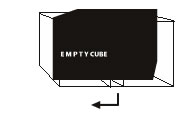IGNASI ABALLÍ
SEPTEMBER, 13, 2013

CONTACTS
iaballi@telefonica.net
EXHIBITION INFORMATION
THREE HOURS OF LIGHT
Wood and candles
Dimension: 320x320x320
A room and a light-box.
The project Ignasi Aballí has conceived for this edition of EMPTY CUBE offers a variety of perspectives on his work. A first inkling of that web of connections can be found in the title of this ephemeral piece: 'Três Horas de Luz' [Three Hours of Light], which combines time, in the precise span of three hours, and light, a material the author has explored in works that employ photography, video or natural lighting, as is the case of one of earlier pieces, 1992's 'Luz (seis ventanas)'.
On the other hand, the title suggests a certain absence of activity, making us wonder whether some event, or action, is taking place beneath the presence of the light, which by its nature is bound to reveal something or draw our gaze to a particular space or object. Another perspective may further engage our attention if we consider the concept of vigil, given that the project takes place at night, within a gallery that contains a second exhibition space, the architectural structure that defines one of the premises behind EMPTY CUBE: a limited space.
Let us return to the title, which acts as a statement of the project, closely connected to its duration, predefined as a single presentation, for a few hours (three, in this case) or minutes of a night. If we look closely at Aballí's work, we will be confronted with a reflection, in a variety of formats, on everyday life and on the temporality that supports it. One brief action is itself a rapport between the process of making and the formulation of thought, like a selective, fragmentary drift that may materialise itself, for instance, as a list of names that obeys an alphabetical or functional metrics, subtly putting into question those statistics or human movements running through a world of which we often only have second-hand knowledge.
In this project, Ignasi Aballí's intervention is reduced to the bare minimum. Nonetheless, his working process brings about a profound alteration, in terms of both function and form, of the temporary space installed inside the gallery. The artist's action has transformed it into a box-shaped screen, within which an image will undergo continual mutations for three hours. It is this transformation, defined by the nature of the luminous materials – a number of lit candles inside the light box/container – that will determine the viewer's time, as the image develops through time while its intensity diminishes. The structure of EMPTY CUBE, which cannot here be accessed as an inner exhibition space, becomes thus a box-shaped screen. The screen takes the place of the structure's former door, lighting and re-shaping the gallery's space as if it were undergoing a natural twilight, as if the space were being contracted by the reduction of its increasingly diffuse limits.
This action, which is unrepeatable even if it should be eventually reconstructed, discreetly evokes the concept of becoming in each infra-moment we witness, while inexorably measuring our presence as beings that exist in the presence of an image in apparent motion, within a cinematic frame of mind, for a three-hour span.
João Silvério
September 2013







